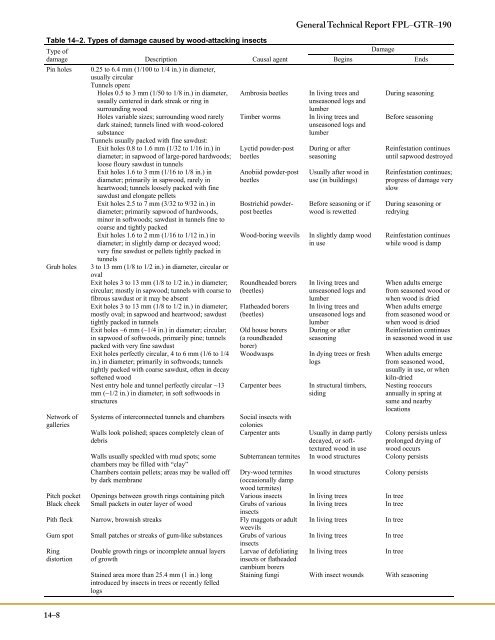Biodeterioration of Wood - Forest Products Laboratory
Biodeterioration of Wood - Forest Products Laboratory
Biodeterioration of Wood - Forest Products Laboratory
Create successful ePaper yourself
Turn your PDF publications into a flip-book with our unique Google optimized e-Paper software.
Table 14–2. Types <strong>of</strong> damage caused by wood-attacking insects<br />
Type <strong>of</strong><br />
damage Description Causal agent<br />
Pin holes 0.25 to 6.4 mm (1/100 to 1/4 in.) in diameter,<br />
usually circular<br />
Tunnels open:<br />
Holes 0.5 to 3 mm (1/50 to 1/8 in.) in diameter,<br />
usually centered in dark streak or ring in<br />
14–8<br />
surrounding wood<br />
Holes variable sizes; surrounding wood rarely<br />
dark stained; tunnels lined with wood-colored<br />
substance<br />
Tunnels usually packed with fine sawdust:<br />
Exit holes 0.8 to 1.6 mm (1/32 to 1/16 in.) in<br />
diameter; in sapwood <strong>of</strong> large-pored hardwoods;<br />
loose floury sawdust in tunnels<br />
Exit holes 1.6 to 3 mm (1/16 to 1/8 in.) in<br />
diameter; primarily in sapwood, rarely in<br />
heartwood; tunnels loosely packed with fine<br />
sawdust and elongate pellets<br />
Exit holes 2.5 to 7 mm (3/32 to 9/32 in.) in<br />
diameter; primarily sapwood <strong>of</strong> hardwoods,<br />
minor in s<strong>of</strong>twoods; sawdust in tunnels fine to<br />
coarse and tightly packed<br />
Exit holes 1.6 to 2 mm (1/16 to 1/12 in.) in<br />
diameter; in slightly damp or decayed wood;<br />
very fine sawdust or pellets tightly packed in<br />
tunnels<br />
Grub holes 3 to 13 mm (1/8 to 1/2 in.) in diameter, circular or<br />
oval<br />
Exit holes 3 to 13 mm (1/8 to 1/2 in.) in diameter;<br />
circular; mostly in sapwood; tunnels with coarse to<br />
fibrous sawdust or it may be absent<br />
Exit holes 3 to 13 mm (1/8 to 1/2 in.) in diameter;<br />
mostly oval; in sapwood and heartwood; sawdust<br />
tightly packed in tunnels<br />
Exit holes ~6 mm (~1/4 in.) in diameter; circular;<br />
in sapwood <strong>of</strong> s<strong>of</strong>twoods, primarily pine; tunnels<br />
packed with very fine sawdust<br />
Exit holes perfectly circular, 4 to 6 mm (1/6 to 1/4<br />
in.) in diameter; primarily in s<strong>of</strong>twoods; tunnels<br />
tightly packed with coarse sawdust, <strong>of</strong>ten in decay<br />
s<strong>of</strong>tened wood<br />
Nest entry hole and tunnel perfectly circular ~13<br />
mm (~1/2 in.) in diameter; in s<strong>of</strong>t s<strong>of</strong>twoods in<br />
structures<br />
Ambrosia beetles In living trees and<br />
unseasoned logs and<br />
lumber<br />
Timber worms In living trees and<br />
unseasoned logs and<br />
lumber<br />
Lyctid powder-post<br />
beetles<br />
Anobiid powder-post<br />
beetles<br />
Bostrichid powderpost<br />
beetles<br />
During or after<br />
seasoning<br />
Damage<br />
Begins Ends<br />
Usually after wood in<br />
use (in buildings)<br />
Before seasoning or if<br />
wood is rewetted<br />
<strong>Wood</strong>-boring weevils In slightly damp wood<br />
in use<br />
Roundheaded borers<br />
(beetles)<br />
Flatheaded borers<br />
(beetles)<br />
Old house borers<br />
(a roundheaded<br />
borer)<br />
General Technical Report FPL–GTR–190<br />
In living trees and<br />
unseasoned logs and<br />
lumber<br />
In living trees and<br />
unseasoned logs and<br />
lumber<br />
During or after<br />
seasoning<br />
<strong>Wood</strong>wasps In dying trees or fresh<br />
logs<br />
Carpenter bees In structural timbers,<br />
siding<br />
During seasoning<br />
Before seasoning<br />
Reinfestation continues<br />
until sapwood destroyed<br />
Reinfestation continues;<br />
progress <strong>of</strong> damage very<br />
slow<br />
During seasoning or<br />
redrying<br />
Reinfestation continues<br />
while wood is damp<br />
When adults emerge<br />
from seasoned wood or<br />
when wood is dried<br />
When adults emerge<br />
from seasoned wood or<br />
when wood is dried<br />
Reinfestation continues<br />
in seasoned wood in use<br />
When adults emerge<br />
from seasoned wood,<br />
usually in use, or when<br />
kiln-dried<br />
Nesting reoccurs<br />
annually in spring at<br />
same and nearby<br />
locations<br />
Network <strong>of</strong> Systems <strong>of</strong> interconnected tunnels and chambers Social insects with<br />
galleries<br />
colonies<br />
Walls look polished; spaces completely clean <strong>of</strong> Carpenter ants Usually in damp partly Colony persists unless<br />
debris<br />
decayed, or s<strong>of</strong>t- prolonged drying <strong>of</strong><br />
textured wood in use wood occurs<br />
Walls usually speckled with mud spots; some<br />
chambers may be filled with “clay”<br />
Subterranean termites In wood structures Colony persists<br />
Chambers contain pellets; areas may be walled <strong>of</strong>f Dry-wood termites In wood structures Colony persists<br />
by dark membrane<br />
(occasionally damp<br />
wood termites)<br />
Pitch pocket Openings between growth rings containing pitch Various insects In living trees In tree<br />
Black check Small packets in outer layer <strong>of</strong> wood Grubs <strong>of</strong> various<br />
insects<br />
In living trees In tree<br />
Pith fleck Narrow, brownish streaks Fly maggots or adult<br />
weevils<br />
In living trees In tree<br />
Gum spot Small patches or streaks <strong>of</strong> gum-like substances Grubs <strong>of</strong> various<br />
insects<br />
In living trees In tree<br />
Ring Double growth rings or incomplete annual layers Larvae <strong>of</strong> defoliating In living trees In tree<br />
distortion <strong>of</strong> growth<br />
insects or flatheaded<br />
cambium borers<br />
Stained area more than 25.4 mm (1 in.) long<br />
introduced by insects in trees or recently felled<br />
logs<br />
Staining fungi With insect wounds With seasoning
















